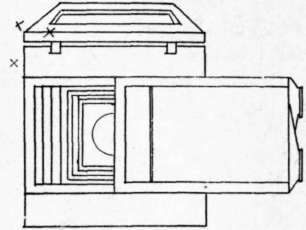Practical Work. Filling The Camera. Continued
Description
This section is from the "First Steps In Photography" book, by J. C. H. Wallsgrove. Also see Amazon: First Steps In Photography.
Practical Work. Filling The Camera. Continued
The lens is opened, and the inverted and more or less blurred image of the object in front of it will be seen on the focussing screen. The milled screw, Fig. 3, I, is turned gently backwards and forwards and the screen carefully watched during these movements; a position will be found at which the centre of the picture will appear perfectly sharply defined. When the lens is of the rectilinear type a point between the centre and the margin must be rendered in sharp focus; afterwards the definition of the whole image is made sharp by reducing the size of the diaphragm opening.
A Critical Survey
Before closing the lens it is well to see that all the parts of the view are in the best position to please the worker's taste. This may be done by loosening the screw F, Fig. 4, and giving the camera a lateral turn to right and left, and by raising and lowering the rise-andfall front. If it has been necessary to tilt the camera, see that the back is perpendicular, if not, make it so by means of the swing movement. The lens is now closed, the focussing screen is swung out of position, and the plate-holder or dark-slide inserted as shown in Fig. 35. Care should be taken to avoid moving the camera when placing the dark-slide in position - as a precaution it should be steadied by placing the left hand on the corner marked XXX. When the plate-holder is in position its slide on the side facing into the camera should be carefully pulled out as far as it will come, and all will be ready for the exposure. This is made by removing the cap or opening the shutter. When sufficient exposure has been given, the lens is again closed and the slide pushed back. It must be carefully remembered which side has been exposed, otherwise the same plate may be inadvertently exposed a second time and thus spoiled. Some plate-holders are numbered - if such be the case make a note of the number. If the holder is not numbered, some mark should be made for guidance.

Fig. 35.
Continue to:


